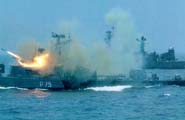Commentary / Admiral J G Nadkarni
Abundance of manpower is likely to make our
armed forces fat and docile
 The Indian Navy owes its emergence as a seapower in the eighties, to a certain extent at least, to the hardware we obtained at rock
bottom prices from the Soviet Union.
The Indian Navy owes its emergence as a seapower in the eighties, to a certain extent at least, to the hardware we obtained at rock
bottom prices from the Soviet Union.
The Rajput class cost less
than a third of their international prices. No longer. As if to
recoup their lost dollars, Russia reportedly wanted a cool billion dollars
for the ten-year-old carrier, Admiral Gorshkov. At about Rs 4 billion to Rs 5
billion, the Gorshkov might have been a good buy, but at Rs 30 billion it would have wiped out the naval procurement budget for five years.
Pakistan today is standing at the edge of an economic precipice.
At least a part of that grave has been dug by the country's armed
forces who have resorted to some profligate spending on defence
in recent years. In 1994, Pakistan signed for three Agosta class
submarines from France at a cost of Rs 10 billion each!
What can countries like India do to cope up with the new reality?
An increase in the defence budget is the inevitable answer. But
there is an obvious limit to what a poor country like India, perpetually
balancing guns against butter, will be able to afford for its
security. Even so, to expect about three and a half per cent of
the GDP to keep the country's body and soul together is not unreasonable.
Unfortunately, the one beneficial fallout of the high costs of
defence has passed India's armed forces by. Greater sophistication
has also brought in its wake a reduction in manpower. High tech
means automated gun turrets, remotely controlled machinery and
precision fired missiles. The capital intensive equipment of today
has resulted in considerable reduction in the number of people
required to fight it. Lean and mean is today's mantra.
India's armed forces have failed to take advantage of sophistication,
which can to some extent offset the high cost of modern equipment.
Having paid an exorbitant amount for a ship, we seem to feel that
we can only get full value if we stuff it with people.
Indian naval ships habitually carry at least 50 per cent more sailors
than their western counterparts. Fortunately for the army and
the air force, space prevents a tank from carrying more than four
and an aircraft can take only one pilot. But they make up in the
tail what the teeth cannot have. Abundance of manpower is likely
to make our armed forces fat and docile.
There is, of course, a silver lining to all this. The high cost
of weapons will eventually drive the government to what the pundits
have been advising it for years. Say, in 2005, both India and
Pakistan will procure about a dozen nuclear weapons each, disband
or reduce their conventional forces, and call that defence.
Retired Admiral J G Nadkarni, former chief of the naval staff, will contribute an occasional column to these pages on national security issues.
|





 The Indian Navy owes its emergence as a seapower in the eighties, to a certain extent at least, to the hardware we obtained at rock
bottom prices from the Soviet Union.
The Indian Navy owes its emergence as a seapower in the eighties, to a certain extent at least, to the hardware we obtained at rock
bottom prices from the Soviet Union.